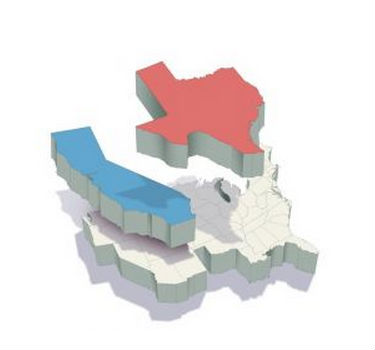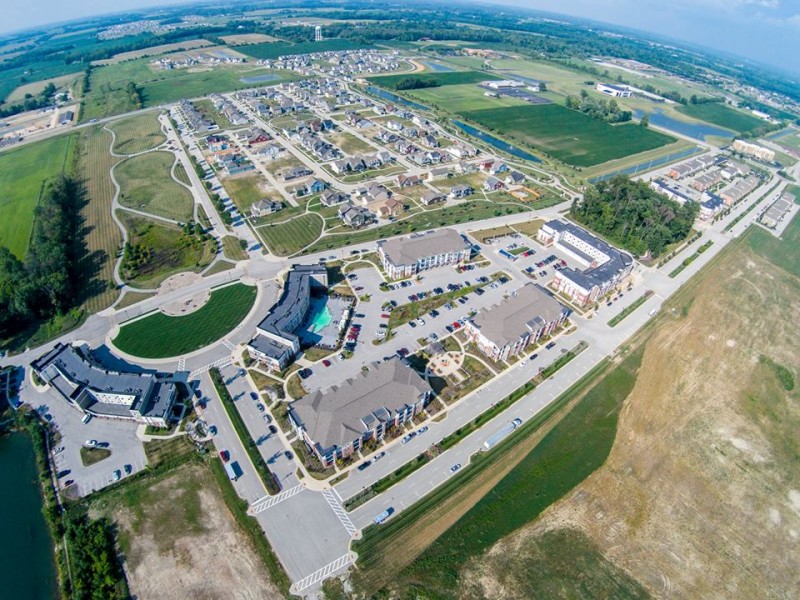Kotkin & Cox: Rise of the nation-states
BY JOEL KOTKIN and WENDELL COX…
 In this highly polarized political environment, states and localities, are ever more taking on the character of separate countries. Washington’s gridlock is increasingly matched by decisive, often “go it alone” polices from local authorities. Rather than create a brave, increasingly federalized second New Deal, the Obama years, particularly since the Republicans took control of the House in 2010, have seen discord rise to a level more akin to that left by James Buchanan, the last president before the Civil War, than Franklin Roosevelt.
In this highly polarized political environment, states and localities, are ever more taking on the character of separate countries. Washington’s gridlock is increasingly matched by decisive, often “go it alone” polices from local authorities. Rather than create a brave, increasingly federalized second New Deal, the Obama years, particularly since the Republicans took control of the House in 2010, have seen discord rise to a level more akin to that left by James Buchanan, the last president before the Civil War, than Franklin Roosevelt.
This makes understanding the sometimes-divergent economic and demographic trends of various states ever more important. With no compelling national vision, not only are politics more “local” but are increasingly distinct by region.
The Main Event: Texas vs. California
Today’s two leading economic models come, not surprisingly, from our two megastates, California and Texas. For its part, the Lone Star State follows a traditional American growth model, spread among a wide array of industries, notably energy, and prodded by population growth.
Since the Great Recession, the Texas model – built around lower taxes, less-stringent regulation and pro-business politics – has been the clearly ascendant of the two, with growth seen along a broad array of industries, including construction, manufacturing and technology, as well as energy. This economic diversity helped the state emerge from the recession far earlier than the rest of the country, recovering its 2007 jobs level by 2011. (California barely crawled into positive territory on jobs this past year.) Texas contributed 23 percent of U.S. economic growth in 2012 and 22 percent in 2011. Without Texas’ growth in this decade, the country could well still be in recession.
For conservatives, Texas has emerged as a sort of Avignon to vie against Obama’s Rome on the Potomac. There is even discussion of a potential presidential bid by former Gov. Rick Perry, whose 2012 foray died during the primary season.
California’s “boom” has come later in the cycle than Texas’, and is far more narrowly based, depending largely on the social media bubble, stock gains among its many wealthy residents and a surge in prices of high-end, coastal real estate. From October 2007 to October 2014, California gained a net 162,000 jobs; Texas in the same period added more than 1.2 million. Surprisingly, notes economist Dan Hamilton, the California tech industry has added barely 10,000 net jobs since 2007.
These divergent growth patterns are reflected in the latest Census numbers. From 2010-14, for example, Texas grew by 1.8 million people, or 7.2 percent. California, in comparison, despite having one-third more people, expanded by 1.5 million residents, or 4.2 percent.
The difference in domestic migration is particularly revealing. Since 2010, Texas has gained over a half million migrants, while California lost 200,000 residents. The Lone Star State has taken over California’s historic role as the primary destination for middle- and working-class people looking to start a new life; the Golden State’s growth now stems from immigration and inertia – from among all the families formed after decades of rapid population growth.
These differences reflect policy choices. California, one can say, charitably, is looking for “quality” growth that touches the environment very lightly and creates high-end jobs, along with many lower-end service positions. Yet many aspects of state policy – the drive for renewables, stricter land-use regulations and expanding the welfare state – makes the Golden State the national model for progressives, even as middle-class and working-class people head for the exits.
Next Up: South Rises Again
Steeply falling oil prices may push Texas, at least temporarily, off its perch as the country’s ascendant nation-state. To be sure, Texas is far more diversified than in the 1980s. The rapid growth of “downstream” industry due to low energy prices, notes former Federal Reserve economist Bill Gilmer, will offset some of the losses in oil exploration and development. Texas, accustomed to being in the lead, may struggle, at least briefly, to keep up with the national economy.
In contrast, falling energy prices could prove a boon to the resurgent U.S. Southeast and its burgeoning industrial base. Cheaper fuel helps a region whose cities tend to be relatively new and car-dependent. Generally low housing costs – usually half or less, relative to income, than in California – draw middle-income families. The area also has an expanding tech sector; half of the nation’s top fastest-growing tech economies, notes Mark Schill, analyst at Praxis Strategy Group, are based in the old Confederacy.
Not that such facts are likely to alter the prejudices of our coastal media. The Atlantic, for example, has proclaimed that the Southeast is “where the American Dream goes to die.”
Facts tell a different story. Florida, which saw actual net outmigration briefly during the recession, since 2010 has gained roughly 400,000 migrants, second only to Texas. Georgia, both Carolinas, and Tennessee also rank among the country’s 10 most-rapidly growing states. North Carolina, with less than half the population of New York state, has added more people since 2010 than the now-diminished Empire State.
Contrary to hopes among some in the media, the Sunbelt is far from dead. Since 2010, the South, including Texas, has gained almost 1.5 million domestic migrants, while the Northeast lost nearly 1 million and the Midwest roughly 500,000. Besides Florida, which ranks second in migration, North Carolina, Georgia and Tennessee are also in the top 10 destinations for domestic migration.
The Mountains and Pacific Northwest
Several Western states – notably, Utah, Colorado, Arizona, Washington and Oregon – rank among the top 10 in population growth. Arizona and Colorado are among the leaders in attracting domestic migrants; since 2010, each state has added 100,000 net new people from other states. In addition, the Dakotas, long among the demographically most stagnant for generations, have also experienced strong population growth and net domestic migration.
Some of this movement, notably in North Dakota, is likely to slow, or even reverse, as oil-drilling activity recedes. The energy slowdown might also hit Colorado and Utah somewhat. But, overall, these states are likely to continue to benefit from outmigration of companies and people from California and from the Northeast.
Politics could intrude in some of these states. Mountain states and the Pacific Northwest are homes to influential environmental and, to a lesser extent, labor, lobbies. High minimum wages, already being implemented around Seattle, may become commonplace while stricter land-use controls and “green” energy policies could continue to push up housing prices in places like Denver, Seattle and Portland.
Canaries in the Coalmine
Perhaps the best way to see longer-term trends is to focus on the “canaries” in the demographic coalmine – millennials and immigrants. The largest generation in American history, millennials, are widely reported to be flocking to big cities along the Washington-to-Boston corridor and coastal California. Yet, according to the Census, the largest increases in millennials are largely not on the coast, but, principally, in the South, in such cities San Antonio, Houston, Orlando, Fla., and Miami.
The big gainer in California? Try the Inland Empire.
This also applies to educated workers ages 25-34, counted from 2010-13. The top six in terms of growth are all in the South – Nashville, Tenn., San Antonio, Austin, Houston, Orlando, Fla., and Jacksonville, Fla. Their ranks of young, educated workers have grown more strongly than in coastal California or Northeastern metropolitan areas. Some locales, such as Portland, Ore., and San Diego, which have prided themselves as magnets for young educated people, seem to be losing their appeal.
Immigrants have accounted for roughly 40 percent of the country’s population growth during 2010-14. Once heavily concentrated in the Northeast and California, immigrants now also appear to be heading to the lower-cost regions of the South and Texas. Indeed, since 2010, the Southeast – including Texas – has led the nation in terms of newcomers, adding 1.5 million immigrants to their populations. This is roughly 50 percent more than the migration to either the Northeast or the West Coast.
Political Implications
The renewed movement of population to the Sunbelt suggests that the South, and parts of the West, will continue to gain influence. California, although clearly still a powerhouse, appears to have passed its demographic apogee and increasingly resembles the slow-growth states of the Northeast.
At the same time, the movement of younger, particularly educated, workers and immigrants could spark a possible leftward shift in some Southern and Western states. Our political future may well be determined by the extent to which geography – the inexorable move to the South and the interior West – overcomes demographics, paced by more left-leaning youth migration and immigration, in determining which of our contesting states eventually control the American future.
Staff opinion columnist Joel Kotkin is R.C. Hobbs Professor of Urban Studies at Chapman University. He is the executive editor of www.newgeography.com. His new book, “The New Class Conflict,” is from Telos Press Publishing.
Wendell Cox is principal of Demographia, a St. Louis public policy consultancy.








